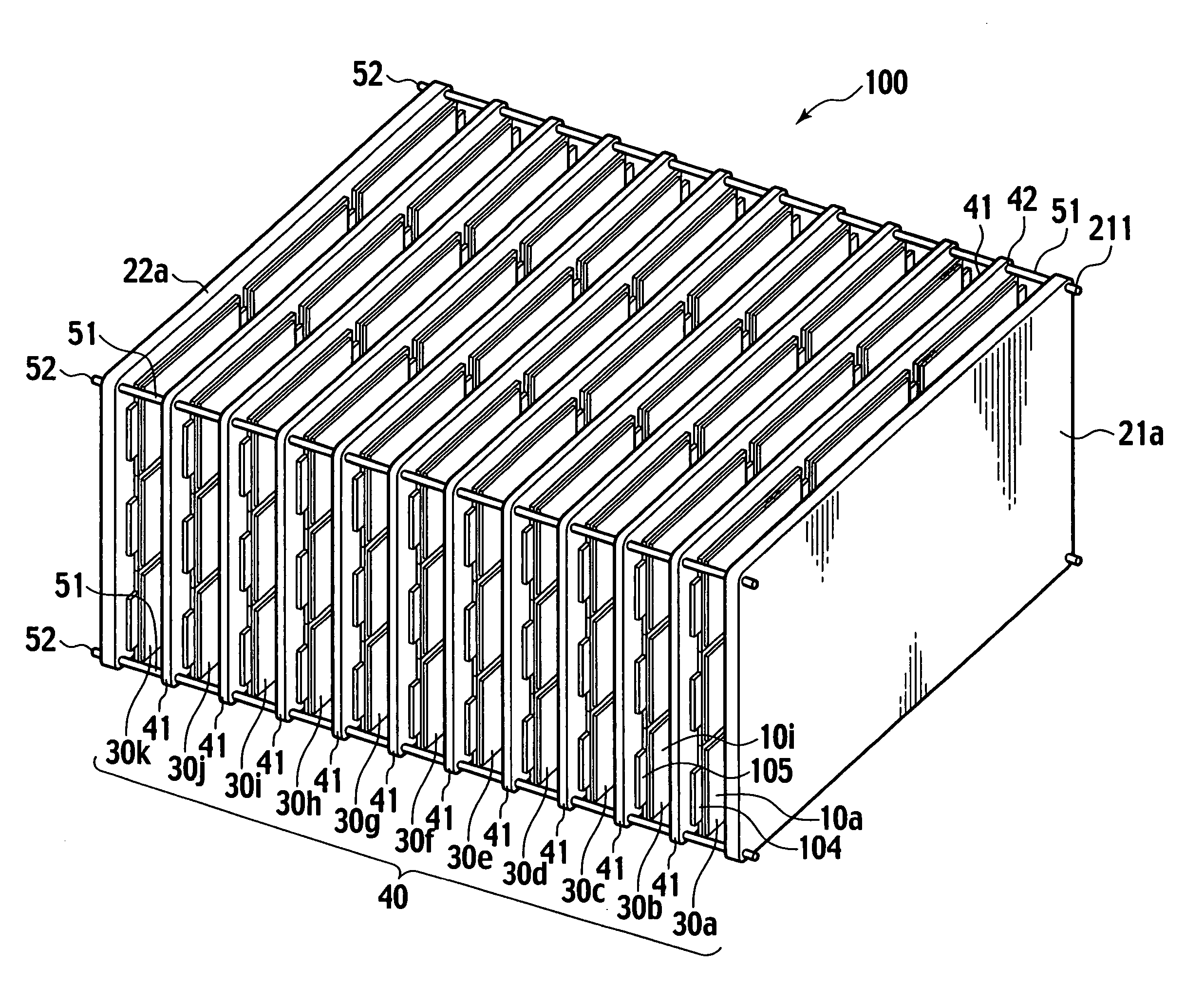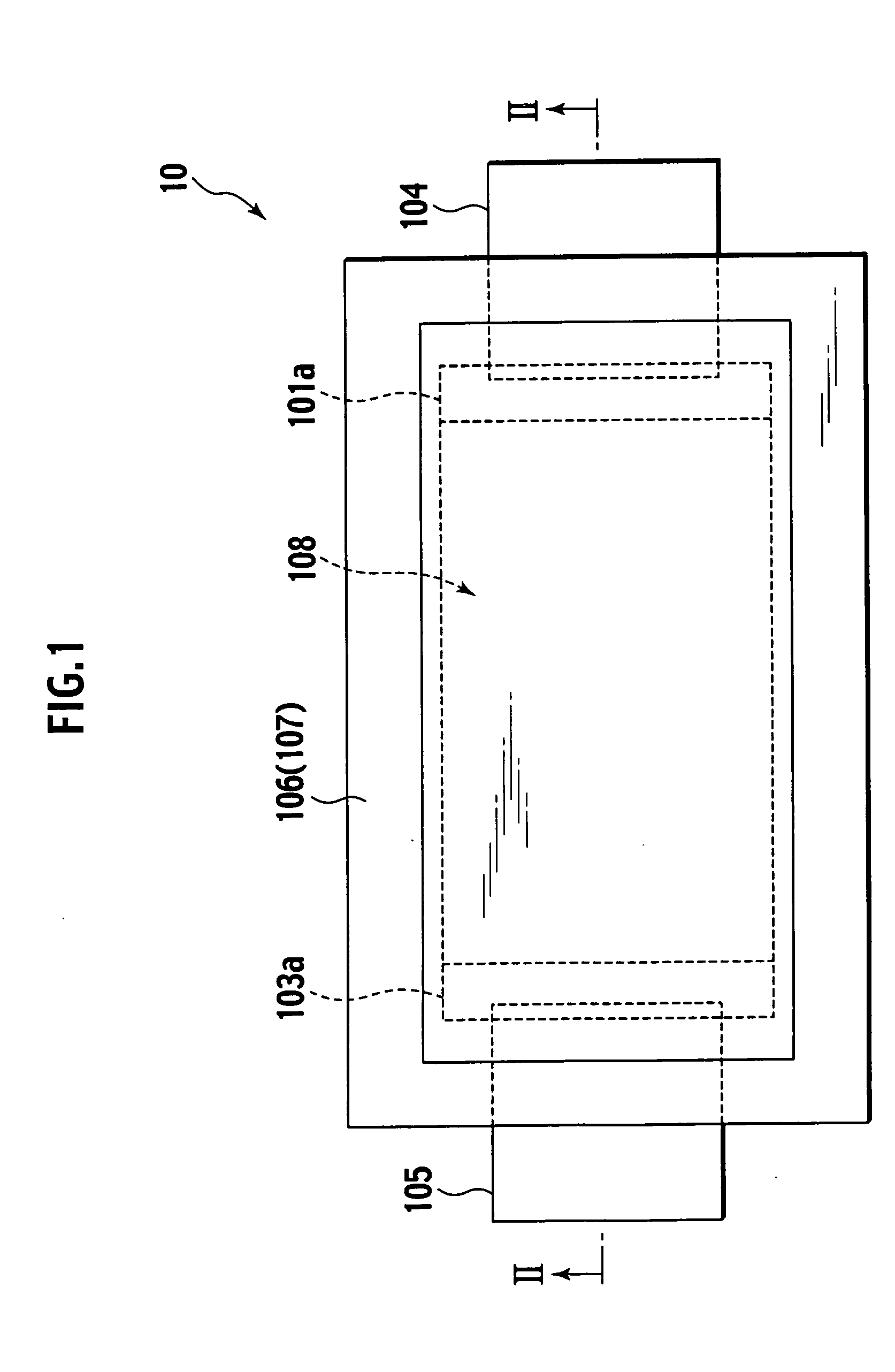Battery
a battery and secondary battery technology, applied in the field of batteries, can solve the problems of difficulty in and the probability of distortion of each restriction plate, and achieve the effect of reliably suppressing a voltage drop in the secondary battery
- Summary
- Abstract
- Description
- Claims
- Application Information
AI Technical Summary
Benefits of technology
Problems solved by technology
Method used
Image
Examples
first embodiment
[0038] First, a battery of a first embodiment according to the present invention is described below in detail with reference to FIGS. 1 to 8.
[0039]FIG. 1 is a plan view of a whole of a secondary battery of the presently filed embodiment; FIG. 2A is a cross-sectional view taken on line II-II of FIG. 1; and FIG. 2B is an enlarged cross-sectional view of a section IIB in FIG. 2A.
[0040] FIGS. 1 to 2B show one thin-type cell (unit cell) 10 forming a secondary battery and stacking a plurality of such thin-type cells forms a battery with a desired voltage and capacity.
[0041] More particularly, the secondary battery 10 is a flat-plate-like stack type thin battery of a lithium-family and is exemplarily comprised of three positive electrode plates 101, five separators 102, three negative electrode plates 103, a positive electrode terminal 104, a negative electrode terminal 105, an upper outer sheath member 106, a lower outer sheath member 107 and an electrolyte that is not shown. Among the...
second embodiment
[0088] Next, a battery of a second embodiment according to the present invention is described below in detail with reference to FIGS. 9A to 9D.
[0089]FIG. 9A is a plan view illustrating an upper end plate of the battery of the presently filed embodiment; FIG. 9B is a front view of the plate of the battery of the presently filed embodiment; FIG. 9C is a side view of the plate of the battery of the presently filed embodiment; FIG. 9D is a graph illustrating the degree (amount) “y” of flexure of the upper end plate of the battery of the presently filed embodiment. Incidentally, in the drawing figures, an inward direction of the battery 100 is designated by “IN” and an outward direction of the battery 100 is designated by “OUT”.
[0090] As shown in FIGS. 9A to 9C, the upper end plate 21b of the presently filed embodiment is set such that a thickness T1 at a pressing center Q is relatively thicker than a thickness T2 of an outer peripheral portion (as expressed as T1>T2).
[0091] With such...
third embodiment
[0093] Next, a battery of a third embodiment according to the present invention is described below in detail with reference to FIGS. 10A to 10D.
[0094]FIG. 10A is a plan view illustrating an upper end plate of the battery of the presently filed embodiment; FIG. 10B is a front view of the plate of the battery of the presently filed embodiment; FIG. 10C is a side view of the plate of the battery of the presently filed embodiment; and FIG. 10D is a graph illustrating the degree (amount) “y” of flexure of the upper end plate of the battery of the presently filed embodiment. Incidentally, in the drawing figures, an inward direction of the battery 100 is designated by “IN” and an outward direction of the battery 100 is designated by “OUT”.
[0095] As shown in FIGS. 10A to 10C, the upper end plate 21c is formed with a plurality of substantially “L”-shaped ribs 24, protruding upward in a direction perpendicular to a surface of the end plate 21c, which are formed on diagonal lines and substan...
PUM
| Property | Measurement | Unit |
|---|---|---|
| thickness | aaaaa | aaaaa |
| rigidity | aaaaa | aaaaa |
| density | aaaaa | aaaaa |
Abstract
Description
Claims
Application Information
 Login to View More
Login to View More - R&D
- Intellectual Property
- Life Sciences
- Materials
- Tech Scout
- Unparalleled Data Quality
- Higher Quality Content
- 60% Fewer Hallucinations
Browse by: Latest US Patents, China's latest patents, Technical Efficacy Thesaurus, Application Domain, Technology Topic, Popular Technical Reports.
© 2025 PatSnap. All rights reserved.Legal|Privacy policy|Modern Slavery Act Transparency Statement|Sitemap|About US| Contact US: help@patsnap.com



